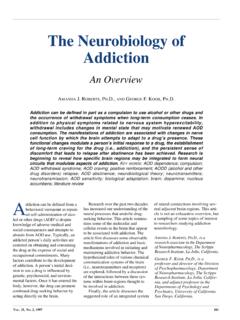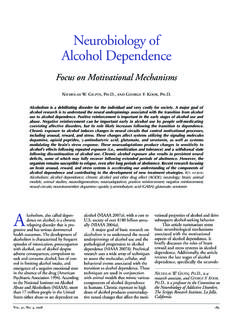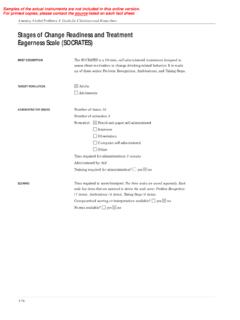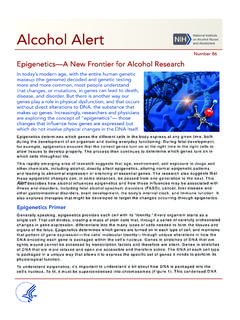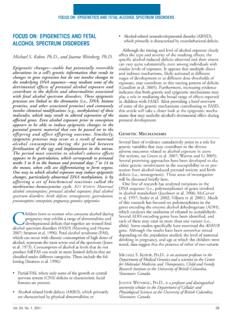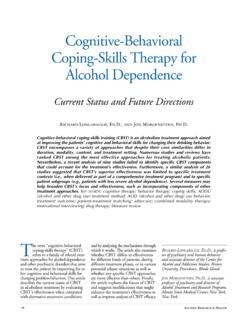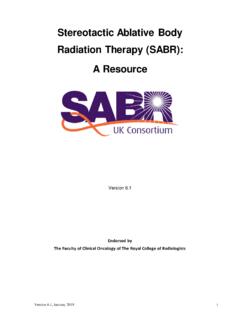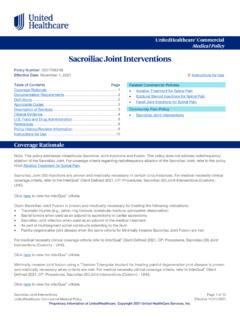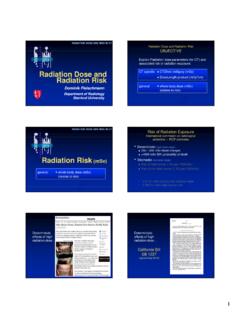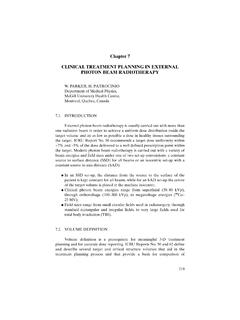Transcription of Alcohol-Related Pancreatic Damage
1 N association between alcohol abuse and Pancreatic injury was reported as early as 1878(Friedreich 1878). Alcoholic pancre-atitis is a potentially fatal illness thatmay be short term ( , acute) or longterm ( , chronic). The relationshipbetween acute and chronic pancreatitisis complex. Symptoms shared by acuteand chronic pancreatitis include dis-abling abdominal pain and interferencewith normal Pancreatic the prevalence of alcoholicpancreatitis in the population is un-known, clinicians usually agree thatboth acute and chronic alcoholic pan-creatitis are responsible for a signifi-cant amount of illness and death in theUnited States. This article discussesthe extent of the problem, clinicalaspects, diagnosis, development ( ,pathogenesis), and treatment of bothacute and chronic pancreas lies deep within theabdomen, behind the stomach. Thepancreas serves two major functions(figure 1). First, certain cells ( , isletcells) dispersed throughout the pan-creas play the role of an endocrinegland by producing two crucial hor-mones that regulate blood-sugar ( ,glucose) levels: insulin and regulated blood glucose canproduce symptoms associated withdiabetes.
2 The hormones produced bythese cells are released directly intothe bloodstream. Second, anotherspecialized group of cells ( , acinarcells) secrete digestive enzymes intothe small intestine through tubes ( ,ducts). In support of its digestivefunction, the pancreas also secretesbicarbonate through these same bicarbonate, a chemicalsimilar to household baking soda,helps adjust and maintain the rela-tively weak acidity required for theaction of intestinal digestive arises in the acinarcells. However, inflammatory damagecan destroy all parts of the pancreas the islet cells as well as the acinar disorder that affects the digestionof food or the subsequent metabolismof digested food in the bloodstream isVOL. 21, NO. 1, 199713 Alcohol-Related Pancreatic DamageMechanisms and Treatment MINOTIV. APTE, , M. MED. SCI.; JEREMYS. WILSON, , ; ANDMARKA. KORSTEN, is a potentially fatal inflammation of the pancreas often associated withlong-term alcohol consumption.
3 Symptoms may result from blockage of smallpancreatic ducts as well as from destruction of Pancreatic tissue by digestiveenzymes. In addition, by-products of alcohol metabolism within the pancreas maydamage cell membranes. Research on the causes of pancreatitis may support moreeffective disease management and provide hope for a potential cure. KEY WORDS:alcoholic pancreatitis; prevalence; pathogenesis; diagnosis; treatmentMINOTIV. APTE, , M. MED. SCI.,is a research officer and , , , is an associateprofessor at the GastrointestinalUnit, Pancreatic Research Group,Prince of Wales Hospital, Randwick, KORSTEN, , is director ofgastrointestinal endoscopy at theAlcohol Research Center, MountSinai School of Medicine, New York,New to have serious consequences forthe entire OF THEPROBLEMS ince Friedreich s initial observation,many studies have confirmed that exces-sive alcohol intake is associated withpancreatic Damage .
4 However, the pro-portion of cases of pancreatitis attributedto alcohol varies widely among countriesand even among different studies in thesame country. In the United States, forinstance, the reported incidence of pan-creatitis attributed to alcohol ranges from5 to 90 percent. This huge variation maybe related to the difficulties in accuratelyidentifying alcohol abuse and to differ-ences in the populations studied. Forexample, in a Veterans Affairs hospital(where the prevalence of alcoholismamong patients is high) (Steinberg andTenner 1994), the number of cases ofalcohol-related pancreatitis is likely to behigher than that in a rural mortality rate of patients withalcoholic pancreatitis is about 36percent higher than that of the generalpopulation. Approximately 50 percentof patients with alcoholic pancreatitisdie within 20 years of onset of thedisease. Only 20 percent of deathsoccurring before a patient s life ex-pectancy are attributed to pancreatitisor its complications; most of thesedeaths are attributed to the effects ofalcohol or smoking on other organssuch as the increased risk of pancreaticcancer reported in heavy alcohol users( , people who consume 10 to 12standard drinks per day)1 by earlierstudies has not been confirmed bymore recent investigations.
5 One com-plicating factor in some of the studiesis cigarette smoking, which is com-monly associated with alcohol the effect of cigarette smokingwas controlled for statistically, noassociation was found between alco-hol abuse and Pancreatic cancer. It hasbeen suggested that the specific riskof Pancreatic cancer among alcoholicsmay be limited to those alcoholicswho develop chronic pancreatitis(Ahlgren 1996). This notion is not un-reasonable, given that an excess rela-tive risk of Pancreatic cancer has beenfound in nonalcoholic types of pancre-atitis, including a hereditary form ofthe disease (Andren-Sandberg andLowenfels 1997). The relationship ofalcohol-related pancreatitis to pancre-atic cancer, however, is less clear,again because of possible contributingfactors, such as malnutrition pancreatitis usually occursin men in their forties. Initial symp-toms include vomiting as well asacute abdominal pain, which may belocalized to the back and upper ab-domen and is relieved by leaningforward.
6 In mild cases, the pain maylast 2 to 3 days; the short-term prog-nosis in such cases is very good. Insevere cases, however, the pain maypersist for several weeks and the riskof death rises to about 30 commonly, pancreatitis can becompletely painless and is only diag-nosed from symptoms of insufficientpancreatic function, such as diabetesand steatorrhea (excess fat in feces).14 ALCOHOLHEALTH& RESEARCHWORLDF igure 1 The human pancreas. (A) View of the pancreas showing clusters ofacinar cells ( , acini), islet cells ( , islets), and Pancreatic ducts. (B)An enlargement of a secretory region of the pancreas. Acini secretedigestive enzymes into the small intestine, islets secrete the hormonesinsulin and glucagon into the bloodstream to regulate blood glucoseconcentration, and duct cells secrete bicarbonate to regulate smallintestine ductsTo SmallintestineIslet cellsAcinar cellsDuct cellsAB1A standard drink is roughly equivalent to theamount of alcohol contained in 12 ounces ofbeer, 5 ounces of wine, or one and a halfounces of 80-proof distilled complication of pancreatitis islocalized masses of dead tissue andold blood walled off between thepancreas and surrounding organs ( ,pseudocysts).
7 If a pseudocyst becomesinfected, it can invade the pancreasand become an 5 to 6 years afterthe onset of the disease (especially inpatients who continue to drink), evi-dence of chronic Pancreatic diseasedevelops as a result of progressivedestruction of Pancreatic tissue ( ,parenchyma). Patients seek medicalattention for persistent pain (whichoften leads to narcotic addiction fromexcessive use of pain medication),weight loss, diabetes, and maldiges-tion of food (a result of inadequateproduction of digestive enzymes bythe pancreas). Abstinence from alco-hol has been shown to slow the rate ofprogression of the disease and de-crease the severity of abdominal recently, it was generallyaccepted that alcoholic pancreatitisbegan as a chronic disease with occa-sional episodes, or acute flareups. This notion was based on results oftissue analyses and x-ray studies takenfrom alcoholics during their first at-tack of pancreatitis that seemed toreveal signs of already existing chron-ic pancreatitis.
8 Among these signswere shrinkage of tissue ( , atro-phy), replacement of healthy tissue byscar tissue ( , fibrosis), and harden-ing of tissue caused by calcium de-posits ( , calcification) (figure 2).Furthermore, autopsy studies demon-strated evidence of Pancreatic fibrosisin alcoholics who had no history ofclinical recent years, the view that alco-holic pancreatitis is a form of chronicpancreatitis has been challenged. Opin-ion is now reverting to the hypothesisfirst put forward in 1946 by Comfortand colleagues, who suggested thatrepeated attacks of acute pancreaticinflammation resultedin chronic pan-creatitis (Comfort et al. 1946). Thishypothesis is supported by both clinicaland experimental studies. A largeprospective study has reported thatchanges in the pancreas related tochronic pancreatitis were more likely tooccur in alcoholics who had recurrentacute inflammation of the pancreas(Ammann and Muellhaupt 1994). Inaddition, a post mortem study of 247patients with fatal alcoholic pancreatitisdemonstrated that in 53 percent of thepatients, no evidence existed of chronicchanges in the pancreas.
9 Experimentsshow that repeated episodes of acutepancreatitis in rats produce chronicchanges in the pancreas, including fatdeposits, atrophy, and fibrosis (Elsasseret al. 1992).DIAGNOSIS OFALCOHOLICPANCREATITISA clinical diagnosis of pancreatitis isusually made on the basis of an attackof severe abdominal pain and tender-ness, accompanied by a rise in theblood level of a Pancreatic enzyme thatdigests starch ( , amylase) to morethan three times the normal 21, NO. 1, 199715 Alcohol-Related Pancreatic DamageFigure 2(A) Abdominal X ray of a patient with alcoholic pancreatitis. Note the speckled calcification ( , calcium deposits) withinthe pancreas (marked by arrows). (B) Abdominal X ray from a subject without amylase in the blood hasbeen the gold-standard diagnostictest for acute pancreatitis for more than50 years. However, recent studiesindicate that up to one-third of patientswith alcoholic pancreatitis may fail toshow any significant rise in amylaselevels.
10 In such circumstances, measure-ment of blood levels of a pancreaticenzyme that digests fats ( , lipase)can be helpful, because serum lipaselevels remain elevated for a longerperiod than do amylase diagnosis of pancreatitis maybe confirmed using imaging tech-niques, such as X ray of the pancreas(which may reveal calcification);ultrasound examination (which pro-vides a two-dimensional image of thepancreas); and computed tomography (CT) to detect calcification and pseu-docysts. The latest development inimaging techniques for Pancreatic dis-orders is magnetic resonance chol-angiopancreatography (MRCP). Thistechnique involves subjecting thebody to a magnetic field and radio-frequency signals and provides excel-lent cross-sectional images of thepancreas and its main duct. It has thepotential to become the diagnostictechnique of choice for patients withsuspected Pancreatic the investigations describedabove provide structural, but not func-tional, information about the determine Pancreatic function,other investigations whether invasiveor noninvasive are necessary.



